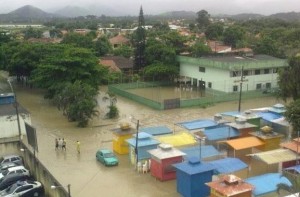Samba is known worldwide as the “national dance of Brazil”, and Samba music with its electrifying rhythms has become a national symbol. It is true, there is a lot of Samba in Brazil – but there is a lot more music in Brazil than “just” samba. In this young country inhabited by immigrants from all continents, music is the same as its people: diverse, open-minded, creative, experimental and curious and deep inside, it is really the specific mixture of all kinds that is “typical Brazilian”.
This letter from Brazil can only take a subjective point of view. Brazilian music mix is so varied, it is different in any place or state in this huge country. Even if all ingredients together form the mixture, they are not equally distributed over the country’s entire geography. Some styles dominate in one area and are almost unknown in another. Samba, for example, is without doubt popular all over Brazil, but in Rio even more than elsewhere. An objective and complete report would certainly fill a book, not just a letter. Additionally to the geographical influence, observation in this field is certainly personally biased; after all, one hears the music played on the parties one goes to and on the radio channels one tunes into.
One thing that is true in the entire country is that national music is far ahead of international trends in popularity. Being a developing country, Brazil still maintains a mentality of having to follow and try to catch up with first world countries in economical, political and educational issues – which is probably true for many – but when it comes to music and football, most Brazilians are convinced that this is where the world can learn from them.
The viewpoint I take in this letter is from Salvador, Bahia, first capital of Brazil (before Rio de Janeiro and, today, Brasilia), and center of African heritage due to the slave trade in the first centuries of Brazil’s existence as a colony and later independent state. As I mentioned in precious letters, Salvador is so close to the Equator that it does not really have summer and winter, much less spring and autumn. To divide the year into seasons, the temperature is of not much use – it remains relatively stable throughout the year, day and night, and feels pretty much like summer. You can rather divide the year into seasons by the weather (dry and rainy season), or… by music. Right, by music. In most parts of the world, you would not exactly listen to Christmas songs in July, and some radio stations identify “the greatest summer hit” of each year, but apart from that, most songs can be played year round. In Salvador, there is a musical calendar. The year begins officially in the summer, in the run-up to Carnival. The music of Salvador’s Carnival is not so much samba, as in Rio, but Axé: happy, fast-paced, light-hearted music with lyrics easy to remember and to sing along, and a dance that might be described as jumping from one leg on the other and sometimes with both at the same time. When Axé singers like Ivete Sangalo, Claudia Leitte, the bands Chiclete com Banana (translated Bubblegum with Banana) and Asa de Aguia (translated Eagle’s Wing) want to make their audience dance, they shout “Tire o pé do chao” (Take the foot off the floor), and are the first to do it themselves.
After carnival, and after recovering from the carnival hang-over, the next big festival to look forward to is Sao Joao (Saint John’s), officially on June 24th, but actually celebrated for at least a week in most small towns in the state of Bahia and the whole region of North-Eastern Brazil. The music of Sao Joao is Forró. Legend tells the name comes from the Brazilian pronunciation of the English “For All”, which apparently they heard as relieved exclamations from English-speaking immigrants when those finally saw a dance style and rhythm which they found they could accompany: significantly slower than samba and with a basic step “two steps right, two steps left”, Forró is indeed much more student-friendly for beginners than other styles. But as often, the devil is in the detail, so that there is a long way to go for foreigners before they manage the swing of the hips quite the way Brazilians do. Apart from that, Forró developed figures of steps reminding partly of Salsa, partly of Rock’n Roll, which most prefer to watch than to try for themselves. Forró music is kind of the Brazilian equivalent of country music; obligatory equipment for a band are Accordeon, Triangle, and peasant’s hats, and lyrics tell funny or melancholic tales of life in the countryside.
The second half of the musical year in Salvador has its climax in December on the national day of Samba with a traditional parade of – of course – samba bands.
Before, after, in between and during these distinct musical seasons, however, a huge variety of styles of music and dance move Salvador year round. Afro-music influenced by the afro-brazilian religion Candomble and its ceremonies, Samba-reggae and percussion by bands such as Olodum, which became world famous with the video clip they produced with Michael Jackson for his song “They don’t really care about us” in the streets of Salvador’s historical Pelourinho district, and styles originating in Samba, such as Arrocha and Pagode are just a few examples. And if you’re looking for it, of course you’ll find Funk from Rio de Janeiro, Bossa Nova, Tropicalia, Reggae, international music and… and… and…
Therefore, whatever your taste… Salvador will have a music for you, in any season.
With best wishes

